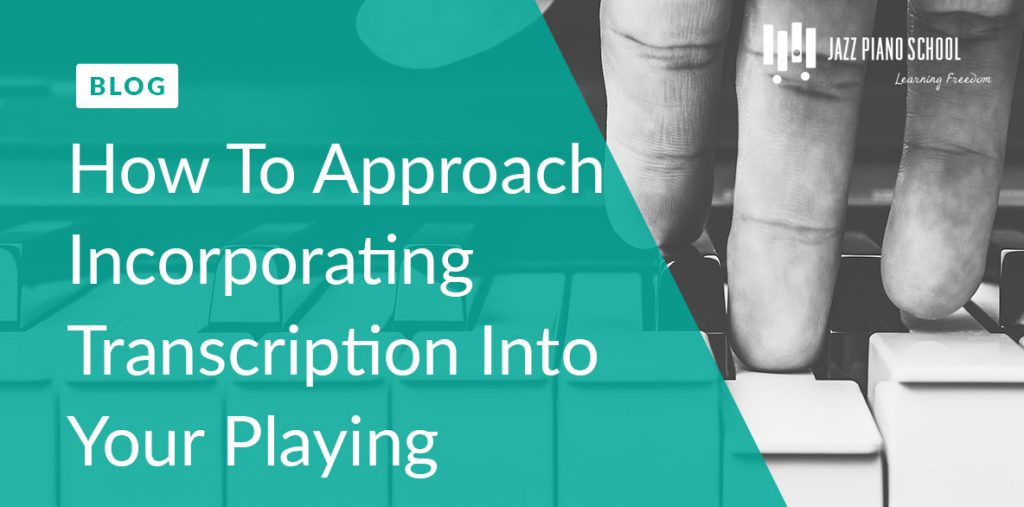-Guest Blog Post Written By Joey Lieber for Jazz Piano School. Joey Lieber is a pianist and piano / music teacher based in Westchester, NY. To follow Joey or for any questions, visit http://www.joeylieber.com
A common question I’ve gotten from students is: “What is the best way to learn new vocabulary?” After all as musicians and improvisers being adept on our instrument and being able to solo over chord changes is a skill both in jazz, as well as other styles of music. Being comfortable with sightreading tunes is important in a variety of gig settings, solo or otherwise.
One of the biggest tools in learning new vocabulary is transcription: Where one learns a solo that has already been done before. The act of transcribing helps a player get into the mind of another musician, and the vocabulary learned from said solo can help a player grow in their understanding of improvisational language.
A common mistake however is that beginning players will learn how to mimic a solo, but will not understand how to incorporate the language of the solo into their playing. It is a lot of information after all, so how do we as players go beyond imitation and into more understanding? How do we translate all that information into practical use where we can grow as soloists?
When starting out with transcription, transcribing an entire solo can be a daunting task. So what I have recommended to students rather is to find recordings they like with solos they enjoy, and find moments they like in the solos and transcribe just those moments. That way instead of having to take on entire solos, they can focus on just the sections they enjoy.
That being said, transcribing entire solos is beneficial as well if one has the time. Seeing how a soloist tells an entire story from beginning to end is a great way to learn how to build a solo and incorporate vocabulary. For beginners however there is nothing wrong with starting out with learning parts of solos that really speak to them.
(Note: Do you want to start learning more about jazz piano in a way that’s organized and structured? Are you looking for a starting point? If so, check out our FREE beginner guidebook to get the scoop!)

When starting a transcription, a great way to begin is to be able to sing the melody line you are trying to transcribe. Becoming familiar with the line will make it easier to transition it onto your instrument. If the line is fast, there is nothing wrong with using software to slow it down to a tempo that is more comfortable for you.
Next is becoming comfortable with the line on your instrument. For pianists, sometimes it helps to vocally sing the line while we are working it out on the piano depending on the line. The process of singing a solo can help a player become more in tune with the rhythms and how it goes. As a pianist, sometimes this is obviously challenge if one is transcribing chords or harmonies, but for single melody lines this can be useful.
Once a line is worked out, there are a variety of different ways to look at it. This is what we are going to examine in this post.
One of the elements is Melody – to look at Melodically what is happening in the line. What are the intervals and distance between the notes? Fourths? Fifths? Etc. Is there a theme that happens? Does the player ascend in 3rds for example? These patterns can help one understand the shape of a line.
As well, one can look at the harmony. Does the line take shape from a certain scale? A mode, a pentatonic? Does it highlight a certain triad or chord? I.E is the line arpeggiating Gmaj 7 chord, over the notated Cmaj7 to create a Lydian sound due to the F#? Just as an example.
In addition, rhythmically what is happening in the line? Are there rhythmic themes and motives the player uses that make it unique? How can we take those rhythms and apply them to other lines to utilize those rhythms in our playing?
There are many ways to look at a transcription. Delving deeper and looking at the melodicism, the harmony, the rhythm, and how it functions can help further understanding, and aid us when trying to translate ideas into different keys, or translate concepts into our playing. Through transcription we can really grow as players as we try and become more adept as improvisers and learn the language.
Joey Lieber is a pianist and piano / music teacher based in Westchester, NY. To follow Joey or for any questions, visit http://www.joeylieber.com
(Note:Don’t forget our FREE guidebook! This is a great place to start your journey in jazz piano. Don’t miss out!)













2 Responses
Good tip about transcription, and learning how to incorporate the language into ones own playing. Can anyone recommend software that slows things down, and doesnt change the pitch?
Hi Ted,
Check out “Anytune.” I’ve recommended it to students and it has been very effective for transcription. It allows you to set markers for yourself in different spots in the transcription, set it to various speeds, etc.
Best of luck,
– Joey